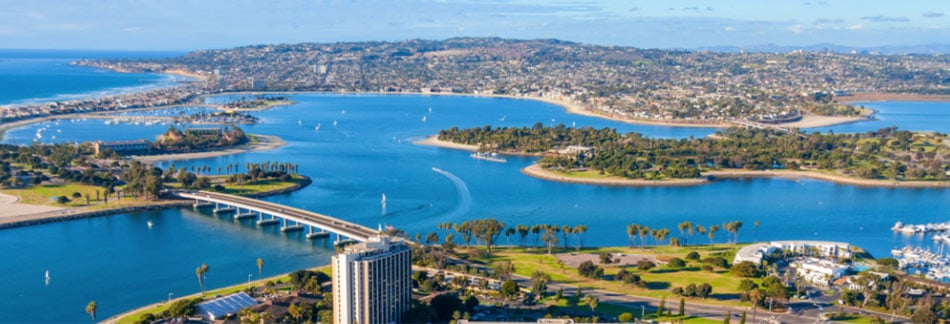At least once a week I’m asked how and when I started sailing. I usually give the short answer, but for the record, here’s the long answer.
Juan Rodríguez Cabrillo, most likely after running his ship aground in 1542, called it “Bahía Falsa,” or The False Bay. This muddy tidal wash where the San Diego River meets the Pacific Ocean was dredged in the 1950s, and Mission Bay was born. A manufactured water playground, home to the first Sea World, Thunderboat races, and over-the-line tournaments, Mission Bay, was an idyllic master-planned beach community complete with an amusement park and hotel bungalows. The bay’s countless bonfire rings illuminate its beaches, where after sunset, parties raged, babies were conceived, and drunken teenagers snuck away from their homes to frolic amidst the smell of bbq, sun lotion, and low tide.
The yearly onslaught of college students from SDSU soon turned this Disney-like community into a true Southern California beach town. The local economy is driven by surfing, cheap food, bars, and head shops. And, with temperatures ranging from the 60s in the winter to the 80s in the summer, if you were homeless, this was the place to hang your hat.

Mission Bay’s boat ramps were just right for our Lido 14 sailboat, trailered behind dad’s 1970 Chevy 3⁄4-ton pickup. Dad and I launched this tiny daysailer into the bay, and my introduction to sailing began. The Lido was number 43. The 43rd Lido built. Its wooden centerboard dropped through the fiberglass hull while the mahogany tiller, strapped to the fiberglass rudder, steered the little boat. The prevailing NW wind put my dad and me in a close reach. I fought to steady the tiller but couldn’t hold a straight course since the Lido would round up into the wind, then fall back and forth like a drunk driver. I’d pull the tiller to my stomach, and the little boat lurched to the right. Panicked, I pushed the tiller away, and she turned into the wind, healed, and fell into irons – the sails flapping violently as we slowly stopped. My dad grabbed the tiller, pulled it to port, and eventually, the bow turned to starboard, and the sails filled again in the breeze. We picked up speed, and I could feel the power of the wind and water against the rudder as the pressure and vibration of the bay journeyed through the tiller into my hands.
Twelve years after my father’s death, I can’t picture his face that well, but I can see his hands. Born late in my dad’s life, I remember how his hands seemed so old with veins, age spots, and hair on his knuckles. His nails were well manicured for his office job, but his fingers and palms were well worn and thick with muscle since he never shied from manual labor. My father’s hands could do anything, fix anything, and if my brothers or I got out of line, correct anything.
“Paul, I want you to look straight across the bay at those buildings on the other side. See that white church, way over there?” I nodded. “Point the bow right at it.” He put his big hairy hand over my tiny seven-year-old fingers and guided me. In a calm voice, he said, “A little port. See that? Now a little starboard, careful, not too much. Feel how the boat wants to do the right thing. Just work with it.” In a few minutes, I made my course good, and I was sailing for the first time in my life. Then he said, “Now close your eyes and feel the boat. Let it talk to you. It will tell you what you should do. “I did as he said, and the little boat gave me the rhythm and language that all sailors understand; and at seven years old, I felt powerful.
We sailed all afternoon in Mission Bay. Tacking, jibing, hiking out while close-hauled, sailing wing on the wing as we spread our sails with the wind behind. Dad took the helm when tacking and would call out with the authority of an Admiral, “Ready about!”
I would call back, “Ready!”
“Helm to lee!” Dad would shout, and in one graceful move, he would push the tiller hard to the lee side of the Lido. The boat would turn on a dime then, and the release of the jib would strip the leeward sheet from my hands as I frantically pulled in the windward sheet. The line would burn my skin, sometimes escaping my hold. We tied the Lido to the launching dock, ate bologna sandwiches, and drank warm Kool-Aid. I was tired and sunburnt, but I felt like a big man.
It’s ironic that now I sail a yacht too big to enter Mission Bay. And it makes me sad to know dad never saw his little sailing lesson’s lasting impact on my life.

